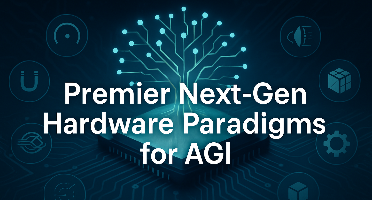
Gabriel Axel Montes
Project OwnerGabriel will manage the project and leverage his cognition background and relationship with the Hyperon team to facilitate alignment between the research and Hyperon team’s AI capabilities.
DEEP Connects Bold Ideas to Real World Change and build a better future together.
Coming Soon
Led by Nature-published Omowuyi Olajide and Gert Cauwenbaughs and neuro/AI research/product and long-time SingularityNET affiliate Gabriel Axel Montes, this proposal undertakes a comprehensive, investigation of eight state‑of‑the‑art hardware architectures and computing paradigms—race logic, analog in‑memory (memristors), analog photonics, asynchronous spintronic computing, stochastic computing, approximate computing, and 3D monolithic integration. The goal is the identification and prototyping of the paradigm that exceeds GPU/TPU baselines on AGI‑specific tasks (recursive reasoning, probabilistic inference, attention mechanisms) in latency, energy efficiency, and scalability.
The purpose of this RFP is to identify, assess, and experiment with novel computing paradigms that could enhance AGI system performance and efficiency. By focusing on alternative architectures, this research aims to overcome computational bottlenecks in recursive reasoning, probabilistic inference, attention allocation, and large-scale knowledge representation. Bids are expected to range from $40,000 - $80,000.
We launch the project by systematically examining eight non-von-Neumann paradigms—race logic analog in-memory (memristor) analog photonic asynchronous SNN spintronic stochastic approximate and 3-D monolithic integration. For each we collect data on computational model fabrication constraints latency energy efficiency and tooling maturity drawn from 2023-2025 publications and reports. Findings are consolidated into a 15-page Research Plan and a concise Mapping Matrix that shows how each paradigm’s strengths map onto Hyperon’s PLN MOSES and ECAN modules and to the five quantitative benchmark metrics. Technical risks and mitigation strategies are recorded for every paradigm establishing a clear evidence-based foundation for all subsequent benchmarking and prototyping.
- 15‑page Research Plan covering computational models fabrication requirements and AGI relevance for eight paradigms. - Mapping Matrix aligning Hyperon modules (PLN MOSES ECAN) with paradigm features and candidate benchmark metrics.
$20,000 USD
- Over 8 paradigms surveyed with more than 3 publications each from recent years (target: 2023–2025). - Over 3 technical risks identified per paradigm, each with mitigation strategies. - Definition of ≥5 quantitative metrics (units and target thresholds). - Peer approval by ≥2 AGI hardware experts.
Building on the survey we produce a 30-page literature review that synthesises ≥50 sources (≥10 from 2025) tracing performance scalability and manufacturability trends for every paradigm and identifying open research gaps. In parallel we implement a Dockerised Benchmark Suite that runs recursive reasoning probabilistic inference and attention kernels representative of Hyperon workloads. The suite reports the five predefined metrics—latency throughput-per-area energy-per-inference scalability exponent and projected TCO—with <2 % run-to-run variance creating a reproducible yardstick that will be applied to all hardware prototypes.
- 30‑page Literature Review synthesizing more than 50 sources including over 10 publications from 2025. - Dockerized Benchmark Suite for AGI workloads with automated dashboards.
$20,000 USD
- Bibliography of ≥50 unique citations with ≥10 from 2025. - Benchmark reproducibility: <2 % variance over ≥3 runs. - Implementation of all five predefined metrics. - Validation with ≥2 domain experts; feedback integrated into v1.0.
We deliver three proof-of-concept implementations: (i) a race-logic accelerator and (ii) an event-driven SNN core on FPGA and (iii) SPICE-level models of memristor crossbars plus photonic MVM circuits. All HDL simulation files and test benches are maintained in a public GitHub repository with continuous integration and ≥80 % unit-test coverage. Each prototype is benchmarked against an Nvidia H100 baseline producing interim latency energy and throughput-per-area results that are compiled in an interim report and reviewed by external experts.
- GitHub Repository containing HDL (race logic SNN) and analog/mixed‑signal models (RRAM IMC photonic MVM). - Interim Report detailing latency throughput per area and energy per inference for each paradigm.
$20,000 USD
- Functional prototypes for ≥3 paradigms. - ≥10 % improvement in at least one metric vs. Nvidia H100 baseline. - ≥80 % unit‑test coverage with CI passing. - Interim report endorsed by ≥2 external reviewers with ≤5 major revision requests.
The highest-performing paradigm is refined to achieve ≥50 % throughput-per-area gain or ≥2 × energy efficiency on the full AGI task suite. Comparative tables a three-year TCO and scalability model and an integration roadmap for Hyperon components are assembled in the Final Report. A demonstration package shows the prototype in action while a manuscript formatted for ISCA or Nature Electronics disseminates the project’s results and positions the technology for adoption.
- Final Report with comparative tables TCO and scalability models and deployment recommendations. - Demonstration Package (video + live demo) showcasing throughput/area gain (target: ≥50 %) or energy efficiency (target: ≥2×) over GPU baseline.
$20,000 USD
- Prototype is benchmarked against target performance metrics, which are optimally met or exceeded, on the selected AGI task. - TCO model demonstrates a payback period (target: ≤3‑years) with sensitivity analysis. - Demo validated by ≥2 AGI researchers. - Manuscript formatted and ready for submission to ISCA or Nature Electronics, as optimal candidates target journals.
Reviews & Ratings
Please create account or login to write a review and rate.
Check back later by refreshing the page.
© 2025 Deep Funding

Join the Discussion (0)
Please create account or login to post comments.